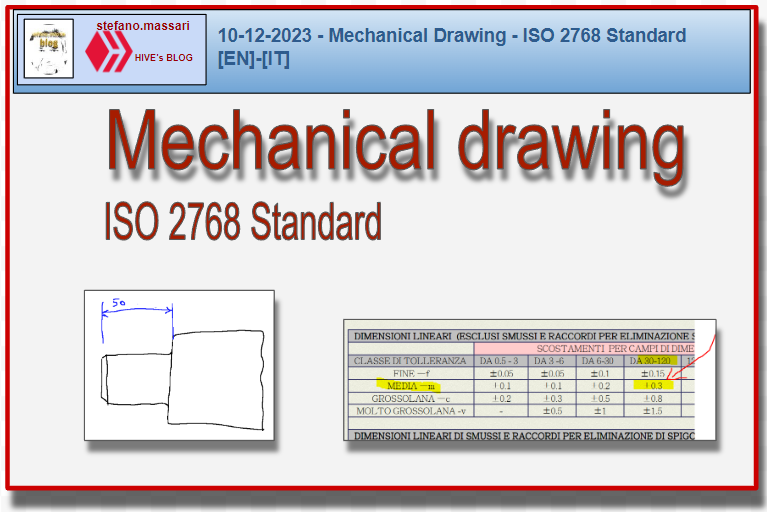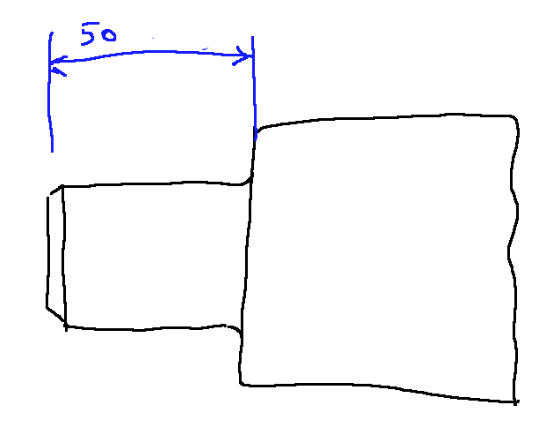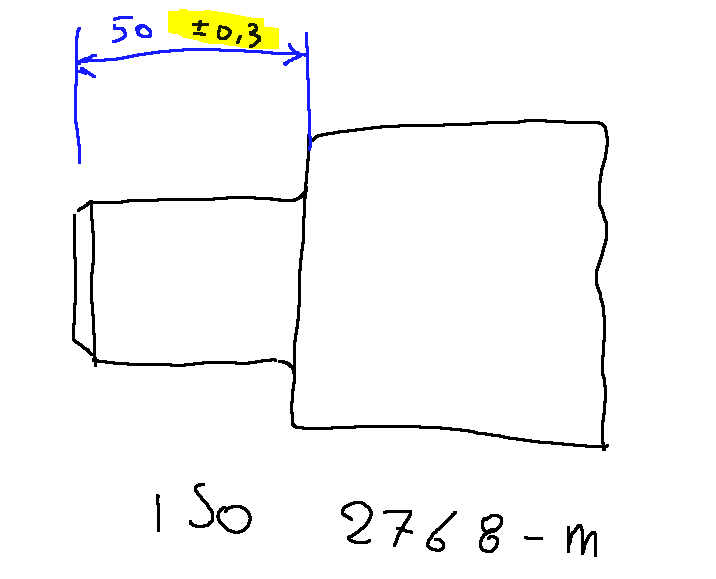10-12-2023 - Mechanical Drawing - ISO 2768 Standard [EN]-[IT]

~~~ La versione in italiano inizia subito dopo la versione in inglese ~~~
ENGLISH
10-12-2023 - Mechanical Drawing - ISO 2768 Standard [EN]-[IT]
ISO 2768 standard
The ISO 2768 standard regulates the general dimensional tolerances of a technical drawing.
Inside the standard there are tables that indicate the tolerances depending on the classes.
The tables contained within are for:
-Linear dimensions (excluding chamfers and fillets to eliminate edges)
-Linear dimensions of chamfers and fillets for the elimination of edges
-Angular dimensions angular dimensions
-General straightness and flatness tolerances
-General perpedicularity tolerances
-General symmetry tolerances
The table for general straightness tolerances is as follows

This table was taken from the following site:
http://www.italautocar.com/images/informazioni_tecniche/pdf/it/tolleranze/UNI_EN_2276_it.pdf
Example 1
Let's take a tree as an example.

The size of the shot is 50, but this is its nominal size.
In reality it cannot be perfect due to the imperfections that mechanical processing can generate.
So to identify the maximum allowable error we are going to check what the designer wrote in the drawing table.
If in the drawing table the general dimensional tolerances are identified as ISO 2768 - m, it means that we must respect the medium class tolerances.
From the table we have that the dimension 50 in the middle class must be ±0.3

So it is as if in the drawing the dimension 50 had marked a tolerance of ±0.3, or rather, whoever processes the piece will have to take into account that general dimensional tolerance.

Conclusions
Even if the dimensional tolerances are not present next to the dimensions, in reality they are never missing. In each drawing table, the general dimensional tolerances that identify the allowable error must be indicated in the title block.

ITALIAN
10-12-2023 - Disegno Meccanico - Norma ISO 2768 [EN]-[IT]
Norma ISO 2768
La norma ISO 2768 regola le tolleranze dimensionali genarli di un disegno tecnico.
All'interno della norma ci sono le tabella che indicano le tolleranze a seconda delle classi.
Le tabelle racchiuse al suo interno sono per:
-Dimensioni lineari (esclusi smussi e raccordi per eliminazione spigoli)
-Dimensioni lineari di smussi e raccordi per eliminazione di spigoli
-Dimensioni angolari dimensioni angolari
-Tolleranze generali di rettilineita’ e di planarita’
-Tolleranze generali di perpedicolarita’
-Tolleranze generali di simmetria
La tabella per le tolleranze generali di rettilineità è la seguente

Questa tabella è stata presa dal seguente sito:
http://www.italautocar.com/images/informazioni_tecniche/pdf/it/tolleranze/UNI_EN_2276_it.pdf
Esempio 1
Prendiamo come esempio un albero.

La dimensione della ripresa è 50, ma questa è la sua quota nominale.
In realtà non potrà essere perfetta a causa delle imperfezioni che possono generare le lavorazioni meccaniche.
Quindi per identificare l'errore massimo ammissibile andiamo a verificare cosa il disegnatore a scritto nella tavola di disegno.
Se nella tavola da disegno le tolleranze dimensionali generali sono identificate come ISO 2768 - m, vuol dire che dobbiamo rispettare le tolleranze in classe media.
Dalla tabella abbiamo che la dimensione 50 in classe media deve essere ±0.3

Quindi è come se nel disegno la quota 50 avesse segnata una tolleranza di ±0.3, o meglio, chi effettuerà la lavorazione del pezzo dovrà tenere conto di quella tolleranza dimensionale generale.

Conclusioni
Anche se le tolleranze dimensionali non sono presenti di fianco alle quote, in realtà non mancano mai. In ogni tavola da disegno devono essere indicate nel cartiglio le tolleranze dimensionali generali che identificano l'errore ammissibile.
THE END
Thanks for this awesome lecture
I appreciate you!
Thanks for stopping by. This rule on general tolerances demonstrates how imagination does not exist in technical drawing, but is full of rules and unifications that have already been written
If only I can still understand this type of drawing, I will really have been happy
This standard defines general dimensional tolerances. This means that if a designer does not indicate the tolerance of the dimension, the person making the piece will still have to rely on the table in this standard to make the piece with a certain allowable error.
Penso che le tolleranze funzionino sempre, l'unico modo in cui fallisce è se il meccanico non capisce bene il disegno e le dimensioni.
anche questo è vero, grazie per aver lasciato un commento.